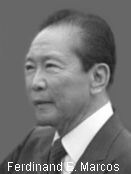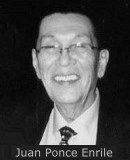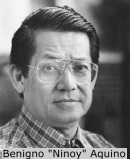|







| |
The Philippines During Martial Law
 Proclamation
of Martial Law: On September 21, 1972, President Ferdinand E. Marcos placed the Philippines
under Martial Law.
The declaration issued under Proclamation 1081 suspended the civil rights
and imposed military authority in the country. Marcos defended the
declaration stressing the need for extra powers to quell the rising wave of
violence allegedly caused by communists. The emergency rule was also intended to
eradicate the roots of rebellion and promote a rapid trend for national
development. The autocrat assured the country of the legality of Martial Law
emphasizing the need for control over civil disobedience that displays
lawlessness. Marcos explained citing the provisions from the
Philippine Constitution that
Martial Law is a strategic approach to legally defend the Constitution and
protect the welfare of the Filipino people from the dangerous threats posed by
Muslim rebel groups and Christian vigilantes that places national security at
risk during the time. Marcos explained that martial law was not a military
takeover but was then the only option to resolve the country’s dilemma on
rebellion that stages national chaos threatening the peace and order of the
country. The emergency rule, according to Marcos’s plan, was to lead the country
into what he calls a “New Society”. Proclamation
of Martial Law: On September 21, 1972, President Ferdinand E. Marcos placed the Philippines
under Martial Law.
The declaration issued under Proclamation 1081 suspended the civil rights
and imposed military authority in the country. Marcos defended the
declaration stressing the need for extra powers to quell the rising wave of
violence allegedly caused by communists. The emergency rule was also intended to
eradicate the roots of rebellion and promote a rapid trend for national
development. The autocrat assured the country of the legality of Martial Law
emphasizing the need for control over civil disobedience that displays
lawlessness. Marcos explained citing the provisions from the
Philippine Constitution that
Martial Law is a strategic approach to legally defend the Constitution and
protect the welfare of the Filipino people from the dangerous threats posed by
Muslim rebel groups and Christian vigilantes that places national security at
risk during the time. Marcos explained that martial law was not a military
takeover but was then the only option to resolve the country’s dilemma on
rebellion that stages national chaos threatening the peace and order of the
country. The emergency rule, according to Marcos’s plan, was to lead the country
into what he calls a “New Society”.
Marcos used several events to justify martial law. Threat to the country’s
security was intensifying following the re-establishment of the Communist Party
of the Philippines (CPP) in 1968. Supporters of CPP’s military arm, the New
People’s Army, also grew in numbers in Tarlac and other parts of the country.
The alleged attempt to the life of then Minister of Defense Juan Ponce Enrile
gave Marcos a window to declare Martial Law. Marcos announced the emergency rule
the day after the shooting incident. Marcos also
declared insurgency in the south caused by the clash between Muslims and
Christians, which Marcos considered as a threat to national security. The Muslims were defending their ancestral land against
the control of Christians who migrated in the area. The minority group organized
the Moro National Liberation Front (MNLF) in Malaysia and pushed for the
autonomy of Mindanao from the national government.
 The
move was initially supported by most Filipinos and was viewed by some critics as
a change that solved the massive corruption in the country. Martial law ceased
the clash between the executive and legislative branches of the government and
a bureaucracy characterized by special interest. Marcos started to
implement reforms on social and political values that hindered effective
modernization. To match the accomplishments of its Asian neighbors,
Marcos imposed the need for self-sacrifice for the attainment of national
welfare. His reforms targeted his rivals within the elite depriving them of
their power and patronage but did not affect their supporters (US Library of
Congress, Martial Law and the Aftermath). The
move was initially supported by most Filipinos and was viewed by some critics as
a change that solved the massive corruption in the country. Martial law ceased
the clash between the executive and legislative branches of the government and
a bureaucracy characterized by special interest. Marcos started to
implement reforms on social and political values that hindered effective
modernization. To match the accomplishments of its Asian neighbors,
Marcos imposed the need for self-sacrifice for the attainment of national
welfare. His reforms targeted his rivals within the elite depriving them of
their power and patronage but did not affect their supporters (US Library of
Congress, Martial Law and the Aftermath).
Thirty-thousand opposition figures including Senator Benigno Aquino,
journalists, student and labor activists were detained at military compounds
under the President’s command (Proclamation 1081 and Martial Law). The army and
the Philippine Constabulary seized weapons and disbanded private armies
controlled by prominent politicians and other influential figures (Proclamation
1081 and Martial Law). Marcos took control of the legislature and closed the
Philippine Congress
(Proclamation 1081 and Martial Law). Numerous media outfits were either closed
down or operated under tight control (Proclamation 1081 and Martial Law).
Marcos also allegedly funnelled millions of the country’s money by
placing some of his trusted supporters in strategic economic positions to
channel resources to him. Experts call this the “crony capitalism.”
 The deterioration of the political and economic condition in the Philippines
triggered the decline of support on Marcos’ plans. More and more Filipinos took
arms to dislodge the regime. Urban poor communities in the country’s capital
were organized by the Philippine Ecumenical Council for Community and were soon
conducting protest masses and prayer rallies. These efforts including the
exposure of numerous human rights violations pushed Marcos to hold an election
in 1978 and 1981 in an aim to stabilize the country’s chaotic condition. Marcos,
in both events, won the election; however, his extended term as President of the
Republic of the Philippines elicited an extensive opposition against his regime.
Social unrest reached its height after former Senator Benigno Aquino was
murdered. The incident sent thousands of Filipinos to the streets calling for
Marcos’ removal from post. Turning again to his electoral strategy, Marcos held
a snap election in 1986 but what he hoped will satisfy the masses only increased
their determination to end his rule that seated Corazon Aquino, widow of Benigno
Aquino, as President of the Philippines ousting Marcos from
Malacañang Palace
and ending the twenty-one years of tyrant rule. The deterioration of the political and economic condition in the Philippines
triggered the decline of support on Marcos’ plans. More and more Filipinos took
arms to dislodge the regime. Urban poor communities in the country’s capital
were organized by the Philippine Ecumenical Council for Community and were soon
conducting protest masses and prayer rallies. These efforts including the
exposure of numerous human rights violations pushed Marcos to hold an election
in 1978 and 1981 in an aim to stabilize the country’s chaotic condition. Marcos,
in both events, won the election; however, his extended term as President of the
Republic of the Philippines elicited an extensive opposition against his regime.
Social unrest reached its height after former Senator Benigno Aquino was
murdered. The incident sent thousands of Filipinos to the streets calling for
Marcos’ removal from post. Turning again to his electoral strategy, Marcos held
a snap election in 1986 but what he hoped will satisfy the masses only increased
their determination to end his rule that seated Corazon Aquino, widow of Benigno
Aquino, as President of the Philippines ousting Marcos from
Malacañang Palace
and ending the twenty-one years of tyrant rule.
Continue to the
EDSA People Power Revolution.
Back to Philippine History - Home Page
|